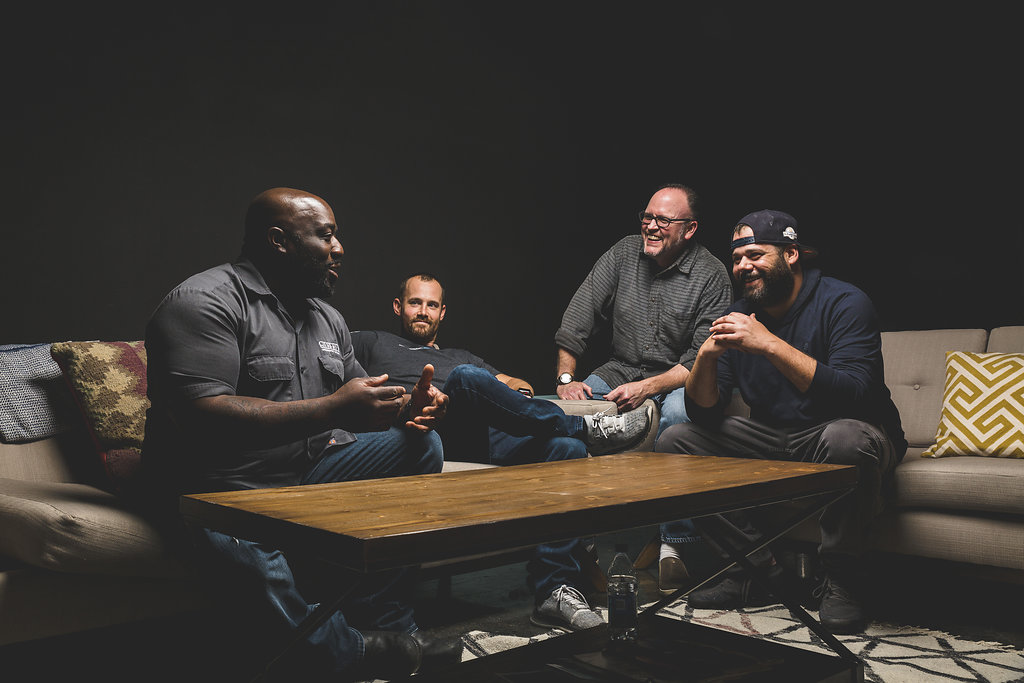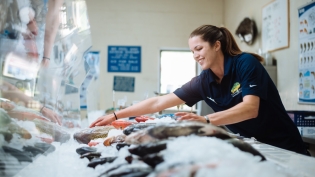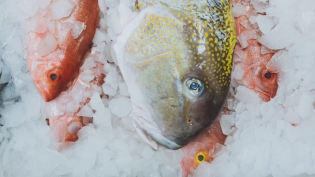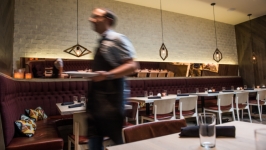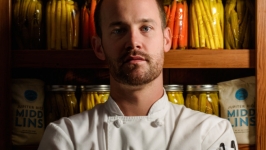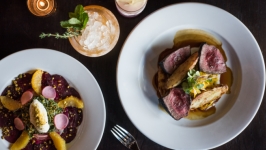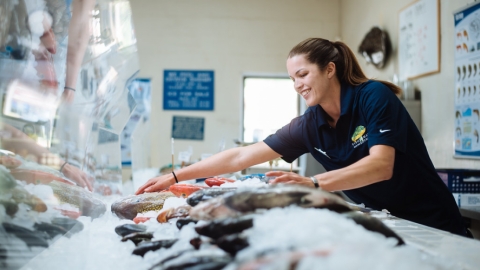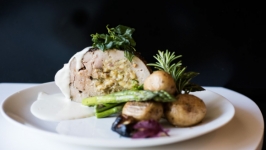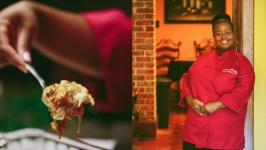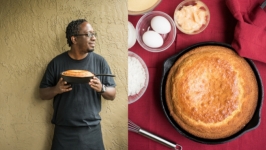Chef's Round Table: Sourcing Seafood
Chef's Round Table is a back-of-the-house conversation series where we sit down with local chefs to get an inside look at the questions and conversations taking place in kitchens throughout Northeast Florida. Chefs will change with each new roundtable, as will topics discussed. For the Coastal Issue, we caught up with:
Chef Tom Gray: Moxie Kitchen + Cocktails, Town Hall
Chef Jon Insetta: Black Sheep, Restaurant Orsay, Bellwether, BLK SHP at Intuition
Chef Brian Whittington: Preserved, Smoked. Southern BBQ
Chef Kenny Gilbert: Gilbert’s UK, Social, Hot Chicken, Southern Kitchen, Beach BBQ
EDITOR’S NOTE: Chefs for our inaugural round table discussion were invited to participate based on the following criteria: participants are chefs-owners of two or more local restaurants who have received national recognition for their culinary pursuits, have drawn national attention to our region and are actively involved in menu development and sourcing for their restaurants. Criteria will change with each issue and chefs invited to participate will vary. Want to be included in the next discussion, or have a chef you’d love to see featured? Drop us a line at editor@edibleneflorida.com.
***********
Our location along the coast, with the Intracoastal Waterway and the St. Johns River as boundaries, would indicate seafood plays a big role in our culinary identity. What has been your experience as restaurateurs? Are diners looking for fish?
JON: You expect us to be a seafood town, with Mayport, Amelia, Fernandina and the history of the area. Restaurants do a lot of seafood but it's not always as local as people think. I know the fish are out there, we have local shrimp and deep sea fishing as well. But the legality of getting that into our restaurants is a challenge. Jacksonville has a strong fishing culture, in that a lot of people go out and fish. But I don’t see that translating into the restaurant scene as much as one would think, living so close to the sea. People like shrimp, oysters, grouper, snapper, mahi ... and Chilean sea bass.
BRIAN: I think we are a seafood area, but I also think people are confused about what type of local seafood we have here.
JON: The question is, culturally, have we lost that relationship with seafood itself, as a city, assuming we had it at some point in time? When I grew up here, there didn’t seem like there was a lot of fresh seafood.
TOM: When I was growing up my dad and I used to buy rock shrimp from a guy selling it on the corner of Blanding Blvd. We would buy 10 pounds, peel them and cook some that night then put the rest in baggies and freeze them for later on.
BRIAN: That’s all the stories we hear though. Back in the day, forty years ago when there was no regulation ...
TOM: It wasn’t that long ago!
BRIAN: You know what I mean. You used to be able to buy seafood from someone on the side of the road who caught it that day. You can’t buy it that way anymore.
KENNY: I started serving mullet on the menu for our fish dip in Fernandina because I was out working the smoker in front of the restaurant and this old-timer came in and said “Hey, when are you going to start doing some mullet?” I asked him what he was talking about and he sat down and gave me the history of mullet in the area, how there used to be trucks going through the neighborhood, selling buckets for $10.
TOM: My dad had an old smoker from Sears, we would smoke mullet, peel off the skin and eat it.
JON: We have a trout dip and that sells. We tried mullet dip, it doesn’t sell. I grew up fishing in Mandarin, and we would never consider mullet an eating fish.
KENNY: We sell so much of it in Fernandina. We actually took the charcuterie board off the menu because we weren’t selling it as much. As soon as we put the fish dip board on the menu, it’s flying out the door.
BRIAN: I think some people in Jax associate mullet with trash fish. It’s pretty accepted in St. Augustine. It has to do with the demographic of the customers.
***********
Let’s talk about fried shrimp, a dish this area is known for regionally. A great deal of shrimp is coming from overseas, Thailand, China, Indonesia and Brazil. What would you like your customers to know about sourcing local shrimp or fish and some of the challenges you face getting a consistent supply of seafood for the volume you need?
BRIAN: Twenty years ago, fried shrimp was the bread and butter of St. Augustine. The top restaurants all competed for who had the best fried shrimp. The culinary scene has come a long way. I was talking to the owner of the Seafood Shoppe in St. Augustine, and he said in the early 1990’s, there were over 40 boats that would come to the docks all the time. Now it is down to 8 or 9 boats. We have guests that come in and ask why we are getting Georgia shrimp instead of local shrimp – not realizing that it is the same shrimp! We try and help educate them on where the shrimp actually comes from. Chain restaurants have seen the success of the local food movement in independent restaurants and they are following along with that trend. They are buying much more local product. We ask our purveyors like Sysco or Cheney Brothers “where’s all the local stuff going?” And they say, “so and so just bought 5000 pounds of local shrimp, so you should probably buy some.” I’m trying to buy as local as possible, but I can’t buy and store 5000 pounds of shrimp. We see this small movement get picked up by the big chains, which then makes it harder for us to source locally.
KENNY: A lot of the catfish we serve is Texas farm-raised. But when I can get it, I buy it through Fisherman’s Dock, from a guy who can hand catch it. When we want whole catfish, we’ll get it from there. The problem is that the size is so inconsistent.
TOM: You brought up a really good point about farm-raised fish. When it comes to educating diners, there’s this push-back, this stigma about farmed fish. I try and buy local fish whenever I can. For our menus, we need quality, consistency, volume. I start by looking at what is local – Georgia white shrimp, I know I can get those. Then I look for other seasonal fish, like triggerfish, to see if that is available. But then you also have to look to quality farmed fish, and you face that stigma. Whenever I have this conversation, with people, I tell people there are bad carrot farmers, and great carrot farmers, bad cattle farmers, and good ones. The same is true with fish farms. Do the research, find out what they are fed and then you can feel good about serving farm-raised fish.
KENNY: We post at the restaurant where our gator comes from, where we get our beef, etc. For our catch of the day, I only want to serve local fish, I don’t want to see Chilean sea bass on the plate. I want truly local. If the fishmonger says he has mullet, we’ll take it. I also want to serve lionfish. I was supposed to start getting it in, but all of a sudden I couldn’t get it. They were sending it all to New York. When I opened Gilbert’s Social, the goal was to have it on the menu, but I couldn’t get it.
JON: When it comes to seafood, we have a hierarchy for sourcing: Wild-caught, then open water farm system, then biodynamic farm system. For instance, our trout is farm-raised in North Carolina. Ideally we would like to have that wild, but the price point would be obscene. There’s no way we could sell that.
TOM: It used to be, you would call your fish guy in the morning to find out what’s available, now we get a text. When I started, in 1999, we had plenty to choose from. There was a tremendous supply, certainly more affordable. Fish pricing today is comparable to beef, if not higher in many respects. It is expected to be less expensive than steak, but typically cost per pound fish is more expensive. At Moxie, given our volume, we can't always get a specific fish so we don't print the type of fish we are serving on the menu because it changes. And actually the demographic dining [at Moxie] hasn’t embraced seafood as much as we anticipated. At Town Hall, we have a fish special every day and typically it is local fish. Going back to the discussion of wild-caught vs. farmed fish, I believe the reality is that we are going to run out of fish due to over-fishing. Not just in Florida, but overall. So if we want the next generations to enjoy seafood, there has to be a balance and we need to look to good fish farming practices. The bigger picture is that we all have a responsibility to purchase and consume with more knowledge, to be aware of and protect our resources as much as we can. I spend a lot of time trying to find that balance.
JON: There’s a lot of potential out there for farming fish, especially as technology improves. But farmed fish is also not inexpensive. If there was any way to work more with local fishermen to get local, high-quality fish at a decent price, I think we would all embrace it. When my partner and I opened Chew, we went to Mayport thinking “We’re going to go meet some fishermen.” We went there and toured the processing areas but [quickly] realized we couldn’t buy direct from the fishing boats.
TOM: There’s a regulation that requires us to purchase from seafood distributors or fishmongers, and although there are no USDA inspections for seafood like there is for beef, legally, you can’t buy it directly off a boat. There are guys out there who try to sell to us. And I would love to buy it, but I don't want to do anything illegal.
JON: I know some chefs have a “shrimp guy.” I’m not sure what that means.
KENNY: Well I have a shrimp guy, Eddie Chesser, who has been shrimping for forty years. If I am doing a shrimp boil, that’s where I get it from, because he will literally go out that morning and get it then bring you a cooler full.
***********
What about the role of a chef in educating consumers about local seafood? How do you help broaden the palate of your customers so that they are interested in more than … Chilean sea bass?
JON: As chefs we need to make sure our wait staff is trained. We need to sell them on the food first, have them believe in it and try it [so they can introduce it to customers]. Once customers are comfortable with the terminology, like crudo for instance (and, as a restaurant, you have their trust), you can then showcase items that are not as familiar in this market. They want to support local food, and so do we, but sometimes there is no rhyme or reason why something sells. Both consumers and chefs have a role in supporting local food.
TOM: Talking about crudos, we rarely serve them through the week, but we can do it on special occasions. We just haven’t had much success, getting dishes like that on the menu on a steady basis.
BRIAN: What about tartares? If you call it a tartare instead?
TOM: I’ve done some off and on, it’s done better. I think it’s because people understand tartare.
KENNY: Funny thing is, if you call it sashimi, and you have fresh citrus, jalapeno and radish, then people will say, “Oh this is great, can I get a side of soy sauce.” A lot of time, it’s the terminology.
BRIAN: It’s important for our customers to learn about the seasonality of local seafood too. Grouper and snapper may not be available locally year-round, and it may be triggerfish season. The farm-to-table movement has been given so much attention, but the seafood side hasn’t really been explained. To be truly local, you have to be open to serving all the fish that people are not used to, like mullet. It’s local, it’s available year-round – but you have guests who want grouper or flounder all year long. So you start to introduce other types of fish and that gives us an opportunity to educate diners.
KENNY: One way it could get better is to create a special and pair it with something the customer is familiar with, something more conducive for them to try it. To see different fish on the menu or special board is part of the education, and that is our job. I tell our servers all the time, they have the hardest job. They have to know all the food and beverages. If they don’t know something we are serving, I tell them to look it up, Google it. Education is power.


